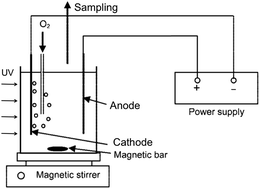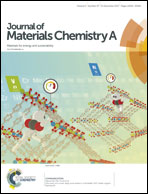A new 3D-printed photoelectrocatalytic reactor combining the benefits of a transparent electrode and the Fenton reaction for advanced wastewater treatment†
Abstract
A new TiO2-coated stirred glass reactor was designed, comprising a film of fluorine-doped tin oxide (FTO) coated on a transparent glass anode. The potential of FTO for the O2 evolution reaction – determined by linear scan voltammetry – was equal to 2.1 V vs. the SHE, high enough to form hydroxyl radicals (˙OH) through anodic oxidation (AO). By letting UVA light shine through the glass reactor coated with an optimal TiO2 loading of 0.311 mg cm−2, heterogeneous photocatalysis occurred, which led to a second source of ˙OH. Coupled with a three-dimensional (3D) carbonaceous cathode and with the addition of a catalytic amount of Fe2+, four more sources of ˙OH could be implemented through H2O2 electro-activation, the Fenton reaction, H2O2 photolysis and Fe(III)-hydroxy complex photolysis. This combined photoelectrocatalytic Fenton process allowed reaching a phenol (chosen as a model pollutant to allow for easy comparison with other processes) degradation rate of 0.0168 min−1 and a mineralization yield of 97% after 8 h of treatment, far better than those of each individual process. Notably, the phenol degradation rate of the combined process was 37% higher than that of electro-Fenton (EF) alone and 42% higher than that of AO alone. A synergy was observed (with a photocatalytic synergy value of SPC = 1.26) in the presence of TiO2, which improved on UV photolysis alone (UV synergy value, SUV = 0.97) and could be further augmented in a novel 3D-printed flow-cell reactor, designed to maximize the distance of electrode separation and the contact between gaseous O2 and the carbon cathode. Indeed, UVA radiation shining through the FTO anode – with a transmissivity of 65% – improved the kinetics of photolytic reactions as compared to dark processes, with a synergy value (SUV) as high as 1.87. Thanks to these enhancements, the overall phenol degradation rate could be further increased to 0.0175 min−1, 14% higher than that within the stirred glass reactor (0.0153 min−1). Following optimization of the current density and Fe2+ concentration, a kinetic rate of degradation of 0.0214 min−1 was attained, an all-time high showcasing the promise of the novel photoelectrocatalytic reactor.



 Please wait while we load your content...
Please wait while we load your content...